論説
Conglomerates are having their day in Southeast Asia.
In much of the rest of the world, conglomerates have lost their luster. Many have been broken up, and those that remain often underperform. They’re commonly viewed as dinosaurs that have long outlived their prime.
But that’s not the case in Southeast Asia, where conglomerates are thriving, in defiance of conventional business theory. In fact, new Bain & Company research reveals just how well they’re doing: Not only are they outperforming conglomerates in developed markets, but they are also consistently delivering higher shareholder value than companies in Southeast Asia that focus on a single business (see Figure 1).
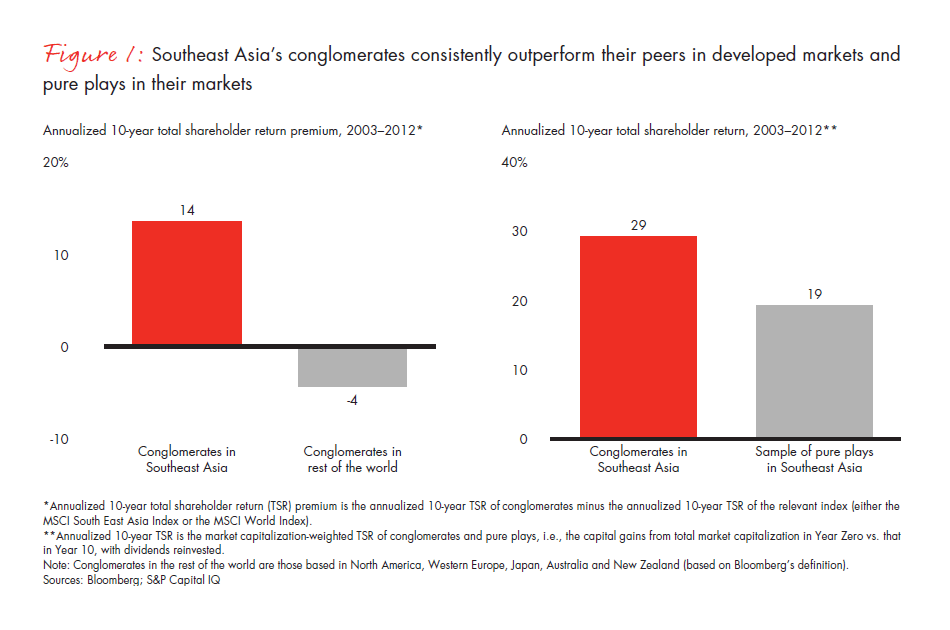
We wanted to learn, in detail, how the region’s conglomerates fared against their counterparts in developed markets and their more-focused rivals close to home. We sought to understand why they’re doing so well, what differentiates the best from the rest and what those leaders are doing to stay ahead. To find the answers, we analyzed the performance of 49 large, publicly traded conglomerates in Indonesia, Malaysia, the Philippines, Singapore, Thailand and Vietnam over a 10-year period (2003–2012), covering both family- and state-controlled groups. We also conducted deep dives into the evolution of a number of these groups in each country.1
Among our findings: The region’s conglomerates achieved total shareholder returns (TSR) that were, on average, 18% higher than those of conglomerates in developed markets and 10% higher than those of selected pure plays in Southeast Asia. (Total shareholder return is defined as stock price changes, assuming reinvestment of cash dividends).
Perhaps most important, we found that there is a predictable pattern underpinning the success of Southeast Asia’s conglomerates that is linked to their home country’s stage of development (see Figure 2). While winning conglomerates throughout the region share many similar traits, the rules for winning and staying ahead in an early-stage economy like Vietnam are different than in Singapore. Likewise, what makes a conglomerate a winner is different in Indonesia and the Philippines than in Malaysia and Thailand. The key to survival and continued outperformance for conglomerates is their ability to adapt their business model as the underlying economy matures.
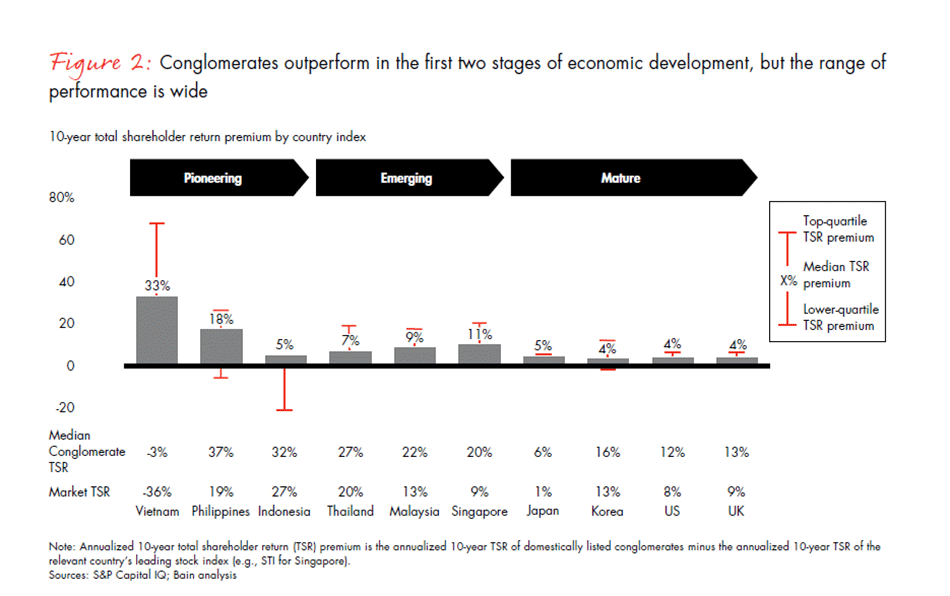
Why Southeast Asia harbors so many successful conglomerates
To learn what it takes to win as a conglomerate, it’s useful to view markets in three distinct stages of economic development:
- Pioneering economies, such as Indonesia, the Philippines and Vietnam, are still in the early stage of industrializing, with a business landscape dominated in many sectors by large local enterprises that are either family owned or state owned or state backed, with a relatively low multinational presence. Capital and talent markets are shallow and relatively inefficient, and formal or informal trade barriers or protections tend to be important.
- Emerging economies, such as Malaysia, Singapore2 and Thailand, are at a more advanced stage of development. As a result, multinational corporations (MNCs) target these markets as a strategic priority, aggressively growing their presence and creating competition for local companies.
- Mature economies, such as Japan, Korea, the UK and the US, are characterized by lower growth, entrenched presence of global competitors, and more mature capital and talent markets.
Our research found that while conglomerates in Southeast Asia typically deliver higher total shareholder returns than non-conglomerates overall, the premium shrinks as economies mature. For example, conglomerates in pioneering markets achieved up to 19% higher TSR than non-conglomerates. But in emerging economies, the best conglomerates only outperform non-conglomerates by at most 5%.
Also, while Southeast Asia’s conglomerates are outpacing conglomerates elsewhere and pure plays close to home, there’s a wide disparity in their performance. For example, Vietnam’s conglomerates saw annual total shareholder returns ranging from 32% to negative 15% over the 10-year period of our study. Yet 21 of the 49 conglomerates we studied are “sustained value creators” (SVCs) that achieved real growth in revenues and profits of at least 5.5 % over the 10-year period while earning back their cost of capital.
Sustained value creators during the 2003–2012 period include Southeast Asian business groups such as Astra International in Indonesia; YTL Corporation Berhad and UMW Holdings Berhad in Malaysia; Keppel Corp. and Sembcorp in Singapore; and Aboitiz in the Philippines. But the list also includes smaller, less well-known regional conglomerates such as Universal Robina Corp. in the Philippines, WBL Corp. in Singapore and Mah Sing Group Berhad in Malaysia.
Five key traits for success
Our analysis helped us identify the five key traits that serve as the foundation for successful conglomerates throughout the region, as well as understand how those traits shift in importance as economies grow.
If there’s a single trait that’s critical for conglomerates operating in any stage of economic development, it’s the need for leadership position (see Figure 3). Here, the data says it all: In Southeast Asia’s pioneering economies, 80% of all top-quartile conglomerates are leaders in their primary businesses. Among conglomerates in emerging economies, 62% of top-quartile performers are industry leaders.
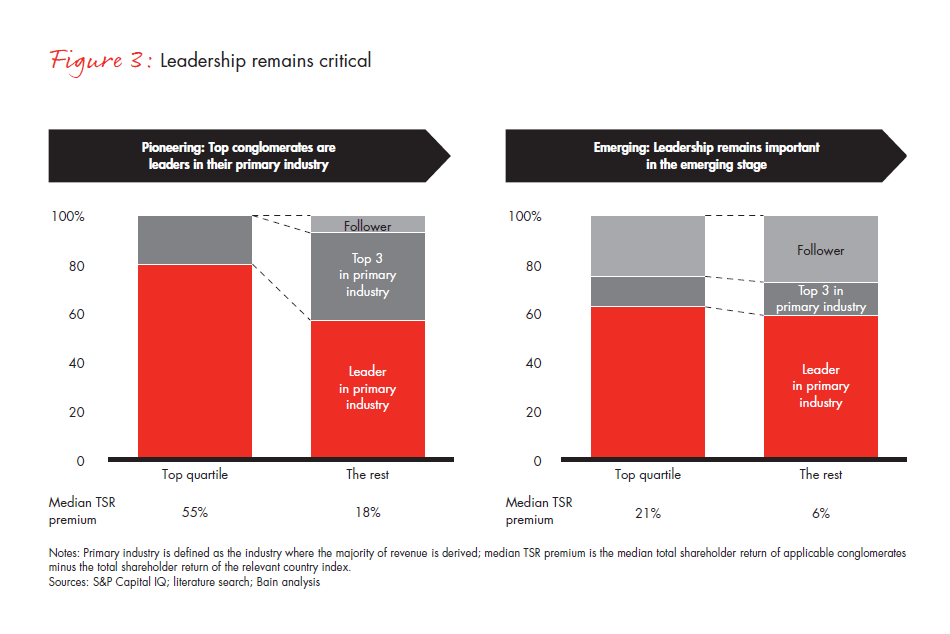
Thoughtful sector selection is a second trait for success. For conglomerates in pioneering economies, there is no substitute for participating in high-growth sectors (see Figure 4). Consider the journey of Indonesia’s Astra International. This conglomerate came to life in the late 1950s as an agricultural produce trader, but throughout the 1960s and 1970s it grew as an assembler and distributor of Honda motorcycles, Toyota cars and Komatsu heavy equipment—providing the critical underpinnings for Indonesia’s development.
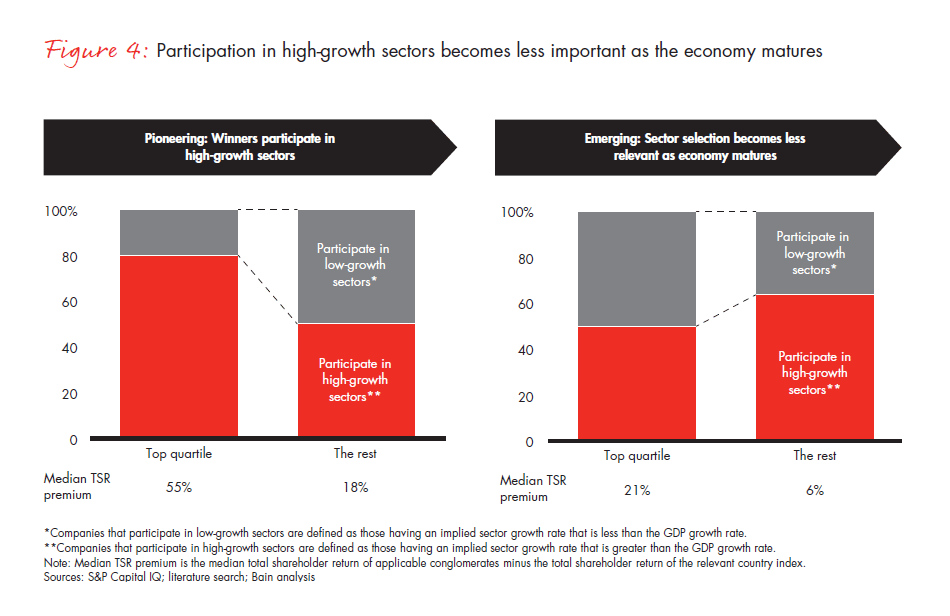
By the end of the 1970s, Astra controlled significant share in heavy equipment, motorcycles and autos— a sector in which it captured 40% of the market.
To expand, Astra then branched out into such areas as computer assembly, before systematically diversifying into other rapidly growing sectors. Today its largest businesses are in automotive, financial services, heavy equipment, mining and infrastructure such as toll roads. While this strategy works well for Astra and other conglomerates in pioneering economies, like Indonesia, Vietnam and the Philippines, the need to participate in high-growth sectors becomes less relevant as an economy matures. At that point, it is far more important to establish leadership positions in the conglomerate’s chosen businesses.
The importance of focus—the third trait—changes, depending on the country or region’s stage of economic maturity. Our research found that for conglomerates in pioneering economies, diversification is important. However, as those economies develop, the most successful conglomerates are those that become increasingly more focused on businesses in which they can establish defensible leadership positions.
Let’s look at Malaysia’s Genting Group. Having established hospitality as one of its core businesses, the conglomerate then concentrated on using that business as a platform for growth. With the opening of Resorts World Casino New York and Resorts World Sentosa, Genting successfully solidified its position as a major hospitality player on the global stage. Only then did it systematically divest its paper and packaging business, reduce its stake in Star Cruises, and scale down power and energy. Hospitality, its core business, now accounts for 90% of its total revenues.
The role of geographic expansion, the fourth trait for success, must also evolve. Conglomerates in pioneering economies are best served by staying local. This positions them to take full advantage of their superior local access and government connections. Only when pioneering economies develop and competition intensifies does thoughtful international expansion become a must.
Historically, conglomerates that expand across borders on the back of a well-developed domestic business do better than those that expand too early or with too many of their businesses.
To see this in action, follow the trajectory of Genting. Founder Tan Sri Lim Goh Tong opened Casino de Genting as Malaysia’s first casino in 1971. By the 1980s, it had more than doubled in size. In the ensuing years, the operation expanded further, encompassing three hotels and a sprawling mountain resort. Only after it had perfected its domestic strategy did Genting expand beyond Malaysia, experimenting with small bets—initially via a joint venture with Stanley Leisure, the largest casino operator in the UK. Next, Genting made a full acquisition of Stanley Leisure, along with a portfolio of high-end UK casinos. It then bought a stake in the second-largest casino operator in the UK, and won the bid to build Singapore’s massive Resorts World Sentosa. As it aggressively pursued this overseas expansion, international revenues steadily rose to the point where they now make up around 60% of the conglomerate’s total revenues.
Finally, successful conglomerates also hone their mergers and acquisitions skills as their economy matures. For conglomerates in pioneering economies, there’s typically a dearth of potential acquisition candidates and, given their advantage as a homegrown enterprise, they generally succeed solely with organic growth. Even in emerging economies, winners continue to rely on organic growth. But a well-devised M&A strategy can yield dividends, especially when it comes to expanding abroad. Then, as the economy evolves further, M&A becomes increasingly important to building the strong leadership positions that sustained success requires.
The rules for thriving
As a region’s economies evolve, so too must its conglomerates. Advances in economic development introduce new challenges, and only the strongest—and those prepared to pivot—will continue to flourish. Again, in pioneering economies, a conglomerate needs to avoid the temptation of geographic expansion and focus first on the lower-risk, local opportunities. And it needs to participate in the growth sectors that underlie the country’s economic development. But, as we mentioned earlier, when that economy moves from the pioneering to emerging stage, the same company needs to focus its portfolio on a much smaller set of businesses and build defensible leadership positions in those. And it needs to thoughtfully take abroad those businesses that face intensifying regional or global competition in their developing economies.
Flourishing conglomerates consistently follow six rules for getting ahead of the curve as their economies develop (see Figure 5).
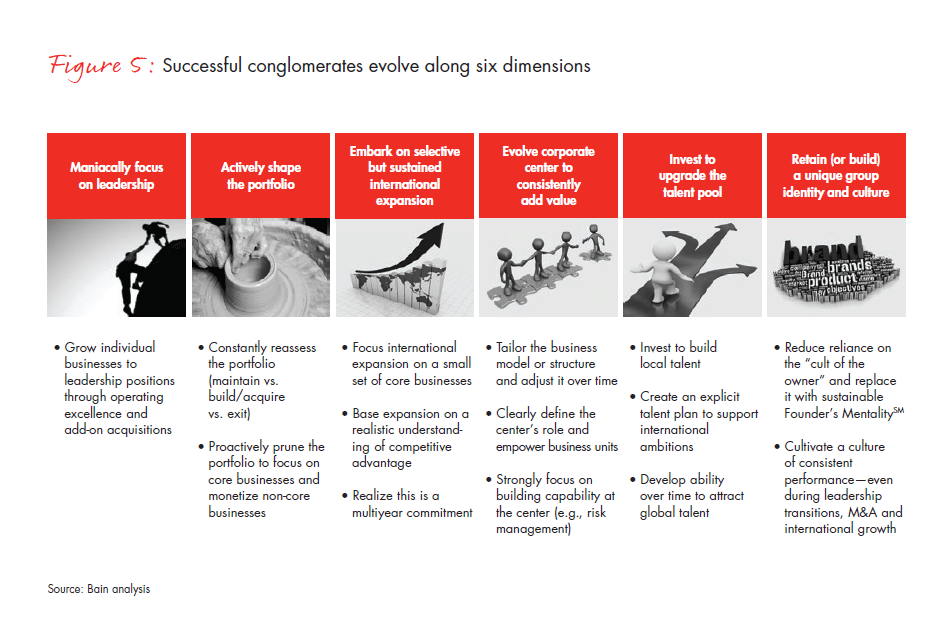
Maniacally focus on achieving strong leadership in each business. To see the importance of leadership position, look at the experience of UMW Holdings, the Malaysia-based industrial enterprise with interests spanning the automotive and energy sectors, and a geographic reach from Turkmenistan to Papua New Guinea. The company’s 10-year total shareholder return exceeded the Bursa Malaysia Kuala Lumpur Compound Index by an impressive 58%.
How did it do that? UMW Holdings wisely pursued the strategy of building a dominant franchise in each business it entered. For example, among UMW Holdings’s businesses, its Toyota forklift franchise has led its industry for 38 years, with a 50% market share. Worldwide, UMV Holdings is one of Toyota forklift’s top five distributors. Similarly, Komatsu commands more than 30% of the heavy equipment market in Malaysia, and UMW Holdings’s Toyota car franchise has been the top foreign car brand in Malaysia since 1990. Today, the overwhelming majority of UMW Holdings’s revenues and profits come from companies in which it is the market leader.
Actively shape the portfolio. As economies expand, that’s the time for conglomerates to trim down their portfolios to a smaller set of leading businesses. That is the successful approach taken by Singapore’s Keppel Corp. and Sembcorp. Both were broadly diversified throughout the 1980s and 1990s, owning businesses from financial services (Keppel TatLee Bank) to property (Keppel Land) to fast food (Sembcorp’s Delifrance) to logistics (SembLog) on top of their original shipyard and engineering businesses. As Singapore became more competitive and the two conglomerates outgrew their home market, both doubled down on three core businesses and divested many of their other holdings. Keppel now focuses on offshore and marine, property and infrastructure; Sembcorp focuses on offshore and marine, utilities and industrial parks. Today, the two companies are leaders in segments of the offshore and marine business, serving customers all over the world.
Pursue a selective but sustained international expansion. The best conglomerates know when the time is right to extend their reach across borders: only after they’ve defined their core business, perfected their operations at home and established a repeatable model for expansion. They start by placing small bets, then they deliberately gain more ground. Sembcorp’s experience shows the benefits of a prudent approach to international expansion. The conglomerate systematically shed languishing, non-core businesses to build on its newly defined core, both in Singapore and overseas. It used those divestitures to fund a steady flow of joint ventures and cross-border M&A activity, gradually becoming a global powerhouse. Through its 2003 joint venture with Shanghai Electric Power and other companies, Sembcorp built China’s largest power plant. And its 2010 acquisition of Cascal expanded Sembcorp’s water utilities footprint to South America and South Africa. Today, Sembcorp’s global core businesses contribute most of its net profits.
Evolve the corporate center to consistently add value to individual businesses and to the group. All global companies struggle to define the role of the center vs. that of local operations. The best companies strive to benefit from the areas where each can deliver the most value. Nearly two centuries old, Malaysia’s Boustead now comprises more than 80 listed and unlisted subsidiaries across six diverse sectors: property, plantation, pharmaceuticals, heavy industries, trading and industrials, and finance and investment. One thing that distinguishes Boustead is an operating model that thoughtfully uses the center to perform targeted activities that support local champions. The center plays a key role in corporate strategy and portfolio management—sourcing acquisitions to improve earnings and overseeing restructuring when needed. It also builds a strong financial platform for the group, unlocking value by listing or delisting companies at the right time.
Invest to upgrade the talent pool. Like most swiftly growing markets, Southeast Asia suffers from a talent gap. There simply are not enough highly skilled people to fill the required jobs, particularly in pioneering economies. And often, top local employees prefer joining MNCs, since they are seen as offering better development programs, more merit-based opportunities and higher pay. The best conglomerates develop strategies to groom their own talent and successfully compete with top MNC employers. Few can match the standard set by the Philippines’s Ayala group of companies in identifying the right talent early, and investing to train and retain top performers.
Each year, Ayala selects around 80 student leaders from the best colleges and universities in the Philippines. Over the course of the four-day Ayala Young Leaders Congress, these selected young people listen as highly respected leaders from government, civil society, business, the arts, and media and entertainment share their leadership stories and experiences. Students participate in outdoor activities, plenary sessions and workshop group discussions, all aimed at honing leadership skills and building a community of learning that will be sustained long after the program ends.
Ayala invests heavily in training, too, with a well-established reputation for tailoring training to the development needs of each department and for partnering with world-class institutions like Harvard University on training programs. To retain top performers, Ayala offers study grants and welcomes individuals at all levels to participate in programs designed to foster its culture of innovation.
Retain (or build) a unique group identity and culture. Keppel was incorporated as a local ship repair yard in Singapore in 1968 and has evolved to become one of the country’s largest conglomerates, with revenues exceeding $12 billion, generated from global businesses. The company’s growth story is one of resilience in the face of such odds as a prolonged market slump that forced the closure of the majority of the world’s rig-building yards. The conglomerate credits much of that endurance to its unique culture of perseverance and passion. Employees—fondly referred to as Keppelites— are schooled in the company’s eight core values, the first of which is simply called “Can Do.” Here’s how Keppel defines that core value: “Having a positive attitude, taking in challenges with vigor and passion in the belief that, no matter how tough the challenge, solutions can be found.”
Even as it expanded its footprint to stretch from Brazil to the US to China, the company worked hard to retain the entrepreneurial spirit of its early days. Bain & Company has studied the multiple benefits of having what we call the Founder’s MentalitySM: the ability to make faster decisions and to adapt and a penchant to quickly redeploy resources toward opportunities. This gives companies an edge over rivals that struggle with issues of decision-making speed, consistent culture and loyalty. The Founder’s Mentality behavior evident in Keppel’s unique culture is something that helps aging conglomerates fight against decay and helps younger ones scale without losing the traits that made them successful in the first place.
Today, Southeast Asia’s conglomerates are riding high. Whether they meet the fate of their counterparts in developed markets—underperforming and facing pressure to be broken up—depends on how well they navigate the changing economic landscape. Ironically, economic development can prove detrimental to some of the region’s thriving conglomerates—but not for those that follow these six critical rules for surviving and rising to the top: strive for leadership position, shape the portfolio, take a selective approach to international expansion, evolve the role of the center for maximum local value, invest to fix the talent gap and retain (or build) a unique culture. That’s what it takes for dinosaurs to flourish.
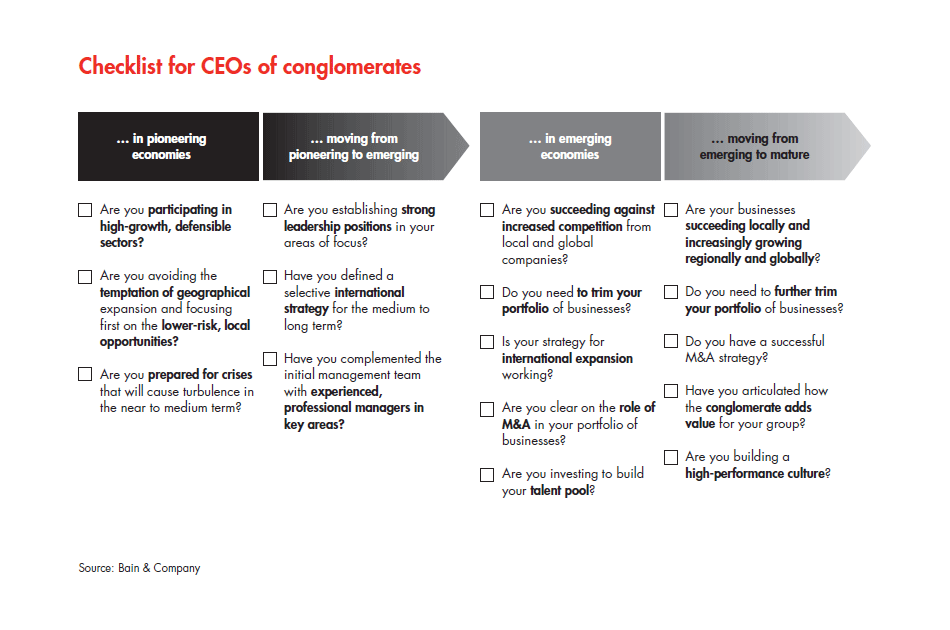
Till Vestring and Dale Hardcastle are partners in Bain & Company’s Singapore office. Jean-Pierre Felenbok is a Bain partner, who heads the firm’s Jakarta office.
The authors would like to acknowledge the support provided by Gerald Tan, manager, and Sameer Mehta, case team leader, in Bain’s Southeast Asia practice and by David Diamond, Bain’s editor for Asia-Pacific.
Founder’s MentalitySM is a trademark of Bain & Company, Inc.
1. Our research only covered conglomerates whose main entity is publicly listed and, therefore, excludes some well-known conglomerates whose main unit is not listed.
2. Singapore’s GNP per capita would indicate it’s a mature economy, but we consider it an emerging economy transitioning to a mature economy. Its growth is significantly higher than many mature economies. Also, as a city economy, it is highly affected by global trade and how its neighbors are doing.





